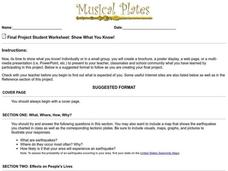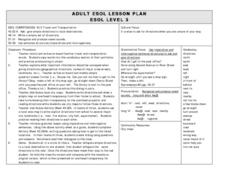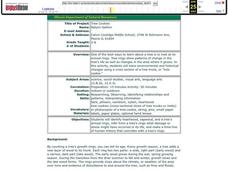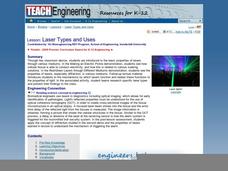Curated OER
Show What You Know!
For this earthquakes worksheet, students create a brochure, poster, or other form of presentation to show what they know about earthquakes. Students complete 4 sections.
Curated OER
Photocells II: The Photoelectric Effect in Photocells
Students discuss the principles of atomic structure that underlie the operation of a photovoltaic cell and explains how they apply to a photovoltaic cell's operation. An area of the classroom is staked off to represent a photovoltaic...
Curated OER
We Have a Dream
Students work as partners to study Dr. Martin Luther King's 'I Have a Dream' speech. In this African American history lesson, students work with their cross-grade partner to study, understand, and memorize the speech. Students meet with...
Curated OER
The Alphabet of Culture
Students research a global culture following teacher-created guidelines and break the culture into small sections. They link the sections and find the influences that each component of culture has on another component.
Curated OER
Governance Grade 10
Students participate in talking circles regarding governance issues. In this self-governance lesson, students examine First Nations and land claims in the Great Slave Lake area in Canada.
Curated OER
Critters R Us or Crime Scene Critters
Students identify nocturnal animals in their local area. Using the internet, they view animal tracks to determine which ones might be in around their school. In groups, they examine outside areas and record their observations. They...
Curated OER
"Critters 'R Us" or "Crime Scene Critters"
Young scholars predict, identify, analyze, and categorize the various nocturnal animals found in their immediate area. They set bait around their school, and try to identify the tracks of the animals that eat the food.
Curated OER
Asking For Directions
Students draw a map of their surrounding area using appropriate landmarks and identifying characteristics. Students ask for and give directions to locations found on their maps to their partner. This lesson is intended for students...
Curated OER
Getting to Know You
Young scholars demonstrate the importance of friendship. In this character education lesson, students read the book Will You Be My Friend? and invite college level young scholars into the classroom. Students discuss what they have in...
Curated OER
Radioactive River
Young scholars work cooperatively as a team to cross a "radioactive" river using a scooter and carpet squares. They discuss and analyze their teamwork and cooperation and the different skills used to complete the activity.
Curated OER
Good Enough To Eat
Students are introduced to the five food groups. In groups, they place different foods into the correct section of the Food Pyramid. Using different types of technology, they create one page of a class ABC book sharing what they know...
Discovery Education
Exploring Geometry
Middle schoolers construct a three-dimensional model of a city using both similar and congruent figures and geometric transformations. City must have at least ten buildings with each building labeled and may be constructed out of paper...
Illustrative Mathematics
Toilet Roll
Potty humor is always a big hit with the school-age crowd, and potty algebra takes this topic to a whole new level. Here the class develops a model that connects the dimensions (radii, paper thickness, and length of paper) of a...
EngageNY
The Volume Formula of a Pyramid and Cone
Our teacher told us the formula had one-third, but why? Using manipulatives, classmates try to explain the volume formula for a pyramid. After constructing a cube with six congruent pyramids, pupils use scaling principles from...
Curated OER
Plate Tectonics Day 3 Sea Floor Spreading: Evidence for Continental Drift
Middle schoolers are introduced to Sea Floor Spreading and how it provides evidence for Hess's and Deitz's theory of Continental Drift. They use paleomagnetic data to calculate the rate of Sea Floor Spreading.
EngageNY
Modeling Riverbeds with Polynomials (part 2)
Examine the power of technology while modeling with polynomial functions. Using the website wolfram alpha, learners develop a polynomial function to model the shape of a riverbed. Ultimately, they determine the flow rate through the river.
National Nanotechnology Infrastructure Network
Biology Reference Sheet
First year life science or biology pupils will appreciate this all-inclusive reference page. It provides a diagram of both a plant and an animal cell, the metric system prefixes, classification levels, definitions for cell processes, the...
Curated OER
Poly-Mania
This hands-on instructional activity takes young geometers on a tour of 2D polygons and 3D polyhedrons. After exploring different web resources and discussing geometric shapes, small groups construct models of polyhedrons using bendable...
Curated OER
Tree Cookies
Students identify heartwood, sapwood, and a tree's annual rings, infer from a tree's rings what damage or stress might have occurred in its life, and make a time-line of human history that coincides with a tree's rings.
Curated OER
Volume of Rectangular Prism and Cylinder
Learners calculate volume of rectangular prisms and cylinders. They draw and label figures to use the formulas to calculate the volume of rectangular prisms. In addition, they use objects to calculate volume in a hands on activity.
Curated OER
Laser Types and Uses
Middle schoolers examine the properties of lasers and research their types and uses. In this laser lesson students view several demonstrations.
Curated OER
Specific Resistance of Conductors
In this conductors learning exercise, students complete 15 problems about conductance, strain gauge, and electrical resistance of conductors.
Curated OER
Stream Study
Students study the characteristics of a stream habitat. In this life science lesson, students use sieves, nets, and jars to collect aquatic organisms. Students also measure the temperature of the stream and calculate the speed of the...
Curated OER
Relative Ages of Rocks
In this rock learning exercise, students are given a diagram of historical events in rock formation and they label the diagram with the events according to the principle of superposition.

























